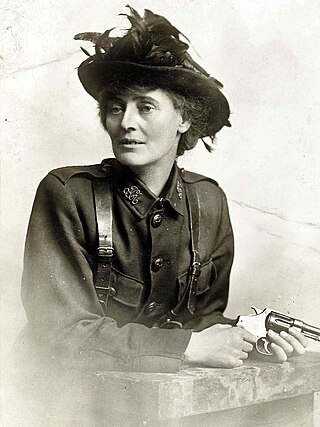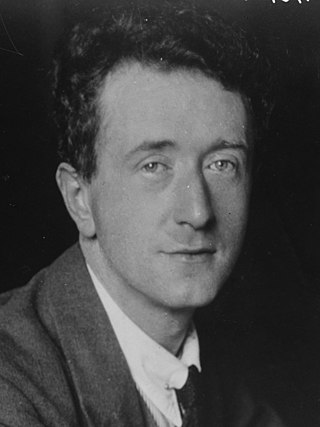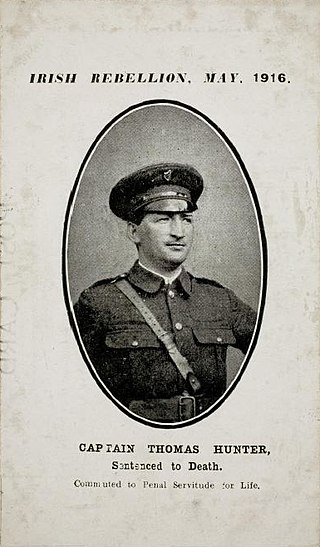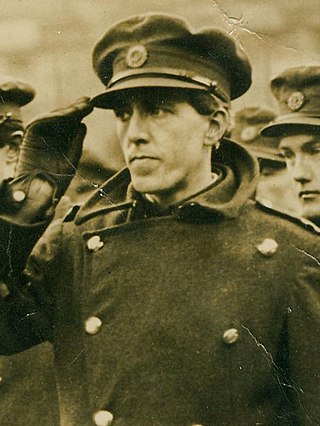
The Easter Rising, also known as the Easter Rebellion, was an armed insurrection in Ireland during Easter Week in April 1916. The Rising was launched by Irish republicans against British rule in Ireland with the aim of establishing an independent Irish Republic while the United Kingdom was fighting the First World War. It was the most significant uprising in Ireland since the rebellion of 1798 and the first armed conflict of the Irish revolutionary period. Sixteen of the Rising's leaders were executed starting in May 1916. The nature of the executions, and subsequent political developments, ultimately contributed to an increase in popular support for Irish independence.

Na Fianna Éireann, known as the Fianna, is an Irish nationalist youth organisation founded by Constance Markievicz in 1909, with later help from Bulmer Hobson. Fianna members were involved in setting up the Irish Volunteers, and had their own circle of the Irish Republican Brotherhood (IRB). They took part in the 1914 Howth gun-running and in the 1916 Easter Rising. They were active in the War of Independence and many took the anti-Treaty side in the Civil War.

Gerald Boland was an Irish Fianna Fáil politician who served as Minister for Justice from 1939 to 1948 and 1951 to 1954, Minister for Lands from 1936 to 1939, Minister for Posts and Telegraphs from 1933 to 1936 and Government Chief Whip from 1932 to 1933. He served as a Senator from 1961 to 1969 and a Teachta Dála (TD) for the Roscommon constituency from 1923 to 1961.

Constance Georgine Markievicz, also known as Countess Markievicz and Madame Markievicz, was an Irish politician, revolutionary, nationalist, suffragist, socialist, and the first woman elected to the Westminster Parliament. She was elected Minister for Labour in the First Dáil, becoming the second female cabinet minister in Europe. She served as a Teachta Dála for the Dublin South constituency from 1921 to 1922 and 1923 to 1927. She was a Member of Parliament (MP) for Dublin St Patrick's from 1918 to 1922.

Desmond FitzGerald was an Irish revolutionary, politician, and poet, known for his role in the Irish independence movement and for his ministerial roles in Irish governments; he was Director of Publicity from 1919 to 1921, Minister for Publicity from 1921 to 1922, Minister for External Affairs from 1922 to 1927 and finally Minister for Defence from 1927 to 1932. Born in London to an Irish family, FitzGerald moved to Paris in his early twenties, where he became involved in the Imagist group of poets. In 1913, FitzGerald returned to Ireland and the next year became active in the Irish Volunteers, a paramilitary organisation that sought Irish independence from Britain. FitzGerald partook in the Easter Rising of 1916 in Dublin and was subsequently imprisoned for two years by the British.

Seán Heuston was an Irish republican rebel and member of Fianna Éireann who took part in the Easter Rising of 1916. With about 20 Volunteers, he held the Mendicity Institution on the River Liffey for over two days, though it was originally only intended to be held for 3–4 hours. He was executed by firing squad on 8 May in Kilmainham Gaol. His court-martial record at Kew spells his name as Hewston J.J..
Events from the year 1916 in Ireland.

Seán Moylan was a senior officer of the Irish Republican Army and later a Fianna Fáil politician. He served as Minister for Agriculture from May 1957 to November 1957, Minister for Education from 1951 to 1954, Minister for Lands from 1943 to 1948, Parliamentary Secretary to the Minister for Finance from February 1943 to June 1943 and Parliamentary Secretary to the Minister for Industry and Commerce from 1937 to 1943. He became a Senator from May 1957 to November 1957, after being nominated by the Taoiseach. He was also elected as a Teachta Dála (TD) from 1921 to 1923 and from 1932 to 1957.

Daniel Breen was a volunteer in the Irish Republican Army during the Irish War of Independence and the Irish Civil War. In later years he was a Fianna Fáil politician.
Cumann na mBan, abbreviated C na mB, is an Irish republican women's paramilitary organisation formed in Dublin on 2 April 1914, merging with and dissolving Inghinidhe na hÉireann, and in 1916, it became an auxiliary of the Irish Volunteers. Although it was otherwise an independent organisation, its executive was subordinate to that of the Irish Volunteers, and later, the Irish Republican Army.

Séumas Robinson was an Irish republican and politician.

Helena Mary Molony was a prominent Irish republican, feminist and labour activist. She fought in the 1916 Easter Rising and later became the second woman president of the Irish Trades Union Congress.

Thomas Cornelius Hunter was a militant Irish republican. He was a member of the Irish Republican Brotherhood (IRB), Sinn Féin, the Irish Volunteers, was twice elected to the Irish parliament, Dáil Éireann, and fought against the forces of the Irish Free State as a member of the Irish Republican Army during the Irish Civil War. While not widely known today, he was present at or directly involved in several major incidents during the struggle for Irish independence from the United Kingdom of Great Britain and Ireland.
The Howth gun-running involved the delivery of 1,500 Mauser rifles to the Irish Volunteers at Howth harbour in Ireland on 26 July 1914. The unloading of guns from a private yacht during daylight hours attracted a crowd, and the authorities ordered police and military intervention. Despite this the Volunteers evaded the security forces and carried away the arms. As the King's Own Scottish Borderers returned to barracks, they were accosted by civilians at Bachelors Walk, who threw stones and exchanged insults with the regulars. In an event later termed the Bachelor's Walk massacre, the soldiers shot into the civilian crowd and bayoneted one man, resulting in the deaths of four civilians and wounding of at least 38.

The first day of the Easter Rising, Monday, 24 April 1916, saw some 1,200 volunteer soldiers of the Irish Volunteers take over positions in the centre of Dublin, launching the week-long revolution known as the Easter Rising.
Joseph John O'Connor was an Irish republican, soldier and politician.

Christopher "Kit" Poole was an Irish soldier and military tactician who fought in the Tirah Campaign and the Second Boer War as a British Army private, as well as a captain of the Irish Citizen Army during the Easter Rising. During the Citizen Army's inception in 1913, he was a member of the group's initial provisional council alongside Captain Jack White, James Larkin, P. T. Daly and Constance Markievicz, and would go on to take up a permanent position on its executive committee. He was also a pivotal figure during the 1916 Easter Rising, as second-in-command at St. Stephen's Green under Citizen Army commandant Michael Mallin where they held out for six days against British forces, ending the engagement when the British brought them a copy of Pearse's surrender order.

Seán MacMahon was an Irish nationalist who fought in the 1916 rising. He took the pro-treaty side in the Irish Civil War (1922–23) and rose to be chief of staff of the Irish Defence Forces
Eamon Martin (1892–1971) was an Irish Republican who fought in the Easter Rising and was chief of staff of Fianna Éireann. He was also a member of the Irish Republican Brotherhood. and a member of the Irish Volunteers executive council.
Mary McLoughlin (1901–1956) was one of the women who actively served in the 1916 Easter Rising. The younger sister of the famed "Boy Commandant General" Sean McLoughlin, at fifteen years old, she served as a dispatcher during the uprising, running messages between the various outposts held by the rebels. She is one of about 2000 participants of the Easter Rising who gave witness statements to document the events in the 1950s, after Ireland gained its independence.
















